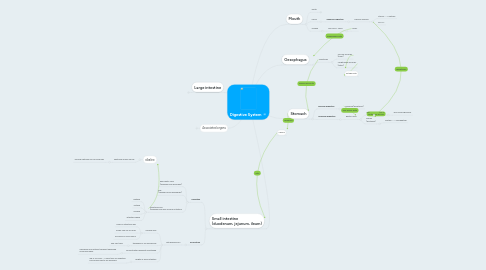
1. Small intestine (duodenum, jejunum, ileum)
1.1. Digestion
1.1.1. pancreatic juice (released from pancreas)
1.1.2. bile (released from gallbladder)
1.1.3. intestinal juice (released from wall of small intestine
1.1.3.1. maltase
1.1.3.2. lactase
1.1.3.3. sucrase
1.1.3.4. intestinal lipase
1.2. Absorption
1.2.1. rate depends on
1.2.1.1. surface area
1.2.1.1.1. folds on intestinal wall
1.2.1.1.2. finger-like villi on folds
1.2.1.1.3. microvilli on villi surface
1.2.1.2. thickness of villi membrane
1.2.1.2.1. one-cell thick
1.2.1.3. concentration gradient maintained
1.2.1.3.1. capillaries and lacteals transport absorbed molecules away
1.2.1.4. length of small intestine
1.2.1.4.1. ard 6-7m long --> more time for digested food molecules to be absorbed
2. Associated organs
2.1. Pancreas
2.1.1. pancreatic juice
2.1.1.1. pancreatic amylase
2.1.1.2. trypsin
2.1.1.3. pancreatic lipase
2.2. Liver
2.2.1. bile
2.2.1.1. bile salts
2.3. Gallbladder
3. Large intestine
3.1. Colon
3.1.1. Absorption
3.1.1.1. water
3.1.1.2. mineral salts
3.1.1.3. vitamins
3.2. Rectum
3.2.1. temporary store of faeces
4. alkaline
4.1. neutralise acidic chyme
4.1.1. provide optimum pH for enzymes
5. Mouth
5.1. Teeth
5.1.1. Physical digestion
5.1.1.1. Chew food into smaller pcs
5.1.1.1.1. Increase SA
5.2. Saliva
5.2.1. Chemical digestion
5.2.1.1. Salivary amylase
5.2.1.1.1. starch ---> maltose
5.2.1.1.2. pH 6-7
5.3. Tongue
5.3.1. Mix food + saliva
5.3.1.1. bolus
6. Oesophagus
6.1. peristalsis
6.1.1. Circular muscles (inner)
6.1.2. Longitudinal muscles (outer)
7. antagonistic
8. Stomach
8.1. Physical digestion
8.1.1. churning (peristalsis)
8.2. Chemical digestion
8.2.1. gastric juice
8.2.1.1. HCl
8.2.1.1.1. pH 2
8.2.1.2. pepsin (protease)
8.2.1.2.1. protein ---> polypeptide
